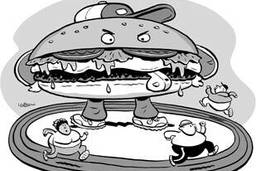Battling Big Cola
Parents and health advocates fight to make sure Pepsi is not the choice of a new generation
Mark Winne

Over the past several years, public school districts have made deals with the likes of Pepsi-Cola and Coca-Cola to keep their school cafeterias operating in the black and to give school principals some extra cash to pay for things like band uniforms. But as one scientific report after another reveals the growing health risks of obesity – especially among children – parents, doctors and nutrition advocates across the nation are marching on their state capitols to demand change. They’ve come to kick out the cola.
Pepsi and Coke are not taking the challenge lying down. Using a page from Big Tobacco’s playbook, Big Cola is pulling out all the stops in a desperate fight to halt state legislatures from enacting tough new nutrition standards for public schools. What’s at stake for the soda companies? Millions of young consumers whose future brand loyalty will be embedded in their malleable cortexes. What’s at stake for the rest of us? A medical bill for obesity-related illnesses that, according to the Center for Disease Control, now stands at $93 billion per year, or 9.1 percent of all U.S. medical expenditures.
Connecticut is the most recent state where citizens have started wondering why their schools are being used as junk food feeding tubes. Under the leadership of Democratic State Senator Donald E. Williams, president pro tempore of the Connecticut Senate, and Lucy Nolan, executive director of End Hunger Connecticut!, both houses of the state legislature have passed by overwhelming margins the toughest school nutrition standards in the country. If Republican Governor M. Jodi Rell signs the bill (as In These Times went to press, a gubernatorial veto was possible), no child will be able to buy a sugary beverage in a Connecticut public school. Instead of agonizing over whether to push the Coke or Pepsi button on school vending machines, little Johnny will only be able to choose from bottled water, 100 percent fruit juice or unsweetened milk.
While Johnny may pout for a while, he may be pleased years later when he hasn’t joined the ranks of the 65 percent of American adults who are now overweight. And Connecticut and U.S. taxpayers may also rejoice when the obesity-related illness portion of Medicaid and Medicare expenditures, which currently stands at $665 million annually in Connecticut alone, begins to decline.
But as Williams and Nolan have learned, anyone who goes up against the carbonated commandos of Big Cola faces an uphill battle. In spite of a statewide opinion poll conducted by the Connecticut Center for Research and Analysis that showed 70 percent of the state’s citizens supporting a school soda ban, Pepsi-Cola and Coca-Cola have each hired the state’s most powerful and connected lobbyists to fight the reform efforts. With combined lobbying fees that approach $150,000 (a small portion of which is also being used to defeat yet another soda industry nemesis, a stricter bottle return law), Big Cola’s hired guns have been stalking the halls of Connecticut’s state capitol, disseminating misinformation and dissembling the issue. Like Iago whispering into the ear of Othello, they have told legislators that the food and beverage menu of local schools is none of their business. According to Nolan, they are saying that what children eat should only be decided by school boards and parents. They have even gone as far as to suggest that state government is disempowering children by taking away their opportunity to buy junk food in school.
Big Cola succeeded in obfuscating the issue so well that Connecticut’s House of Representatives debated the soda ban for an astounding eight hours – far more time than they devoted to any other issue this session, including the nation’s first legislatively authorized same-sex civil union bill and a failed attempt to outlaw state executions. End Hunger’s Nolan, a mother of three school-age children, credits Williams for standing strong in the face of unrelenting lobbying pressure. “You have to be willing to go up against the state’s toughest lobbyist,” Nolan says. “Just look at how much money they spent!”
Such resolve doesn’t appear to be the forthcoming in this year’s Oregon legislature. Mary Lou Hennrich, director of the Community Health Partnership, is leading a group of health organizations, medical associations and academics called the Oregon Nutrition Policy Alliance. Together, they put forward legislation to reform the state’s school food environment with a special emphasis on reducing the availability of unhealthy food. When the advocates made a few technical missteps, Big Cola immediately started sowing the seeds of discontent. “They went around to school food service directors and local officials telling them they shouldn’t let state government tell them what to do,” Hennrich says. Big Cola even had the chutzpah to bring in a school board official from Eugene who testified against the healthy school food bill. It turned out that he was also the president of a local Pepsi bottling company. According to Hennrich, the bill is now in serious trouble.
Joy Johanson, senior policy associate at the Washington, D.C.-based Center for Science in the Public Interest, has seen this pattern time and again. She points out that the food and beverage industry has become quite adept at playing a game of semantics that disorients overworked state legislators and confuses the general public. For instance, the word “ban,” as in “soda ban,” has been translated by Big Cola to mean that Big Brother is treading on your civil liberties.
“The local control message that keeps surfacing throughout this debate,” Johanson says, “is not coming from parents or even particularly from local school authorities; it’s coming from Coke.” She notes that 90 percent of all local school districts don’t have a certified nutrition professional on staff, which means that a state-level person qualified to make decisions based on the best scientific information is a boost to local schools, not a hindrance as Big Cola suggests. Of course, no one complains when state boards of education require a minimum number of courses in English and math to earn a high school diploma, or when the federal government demands compliance with “No Child Left Behind.”
“Healthy school food has become a politically contentious issue when it should be a bipartisan one,” Johanson says. “After all, we’re talking about our children’s health.”
But even when Big Cola knows it has to retreat, it finds a way to fight a successful rearguard action. After a hard-fought battle in this year’s New Mexico legislature, pediatricians, school food directors and nutritionists managed to secure legislative consent for an expert committee with the authority to establish nutrition standards for schools. But there was a cost. The legislature required that the committee members include representatives of the beverage and food industry. In other words, Big Cola convinced the legislature that the fox should join the chicken coop’s security guard.
A 20-ounce bottle of Coke contains no less than 16 teaspoons of sugar. Today, 56 to 85 percent of children consume at least one soda daily in school, in spite of the fact that the American Academy of Pediatrics has declared that soda should not be sold in schools – period. Yet Big Cola and its hired guns are spending millions of dollars at all levels of government to retain what they claim as their right, and presumably that of local schools, to give children their daily sugar fix.
It’s not that children aren’t otherwise bombarded with consumer messages – on television, at the mall and from their peers. It’s just that maybe public schools should offer a sanctuary from life as one big commercial.
Marion Nestle, a professor of nutrition at New York University, put it this way: “There needs to be one place in society where children feel that their needs come first – not their future as consumers. In American society today, schools are the only option. That’s why every aspect of school food matters so much.”








